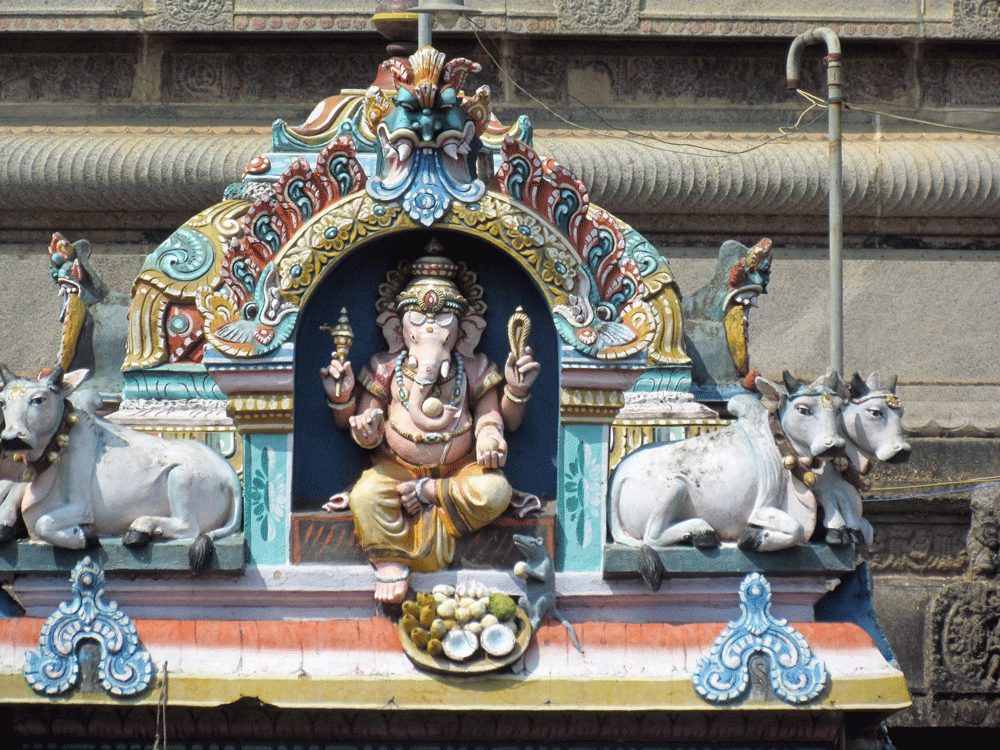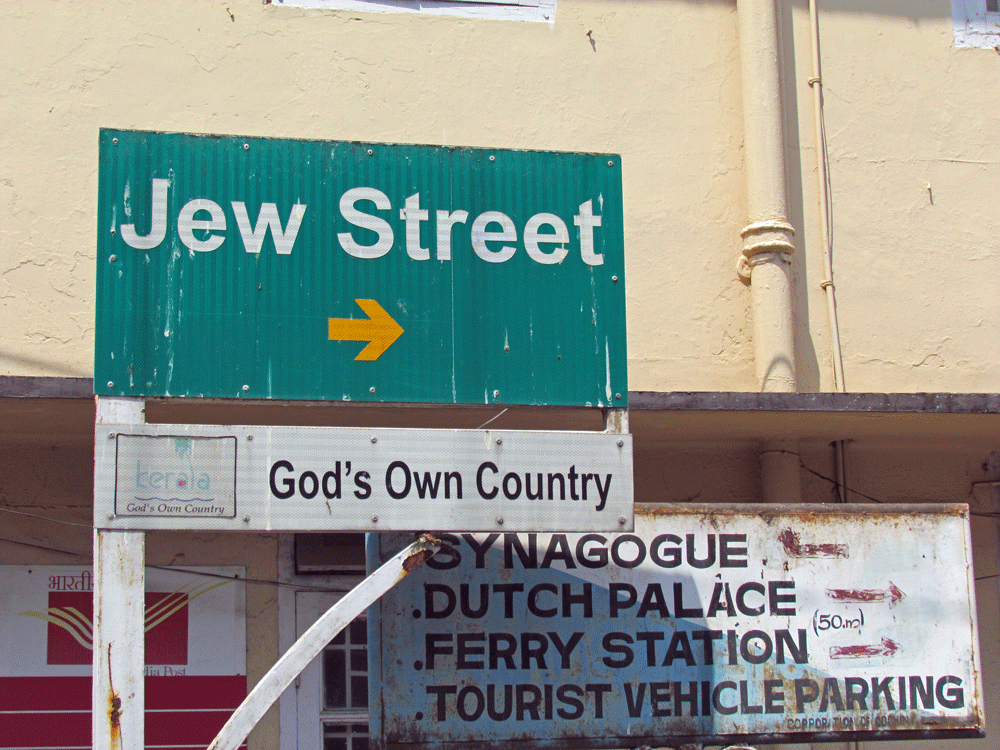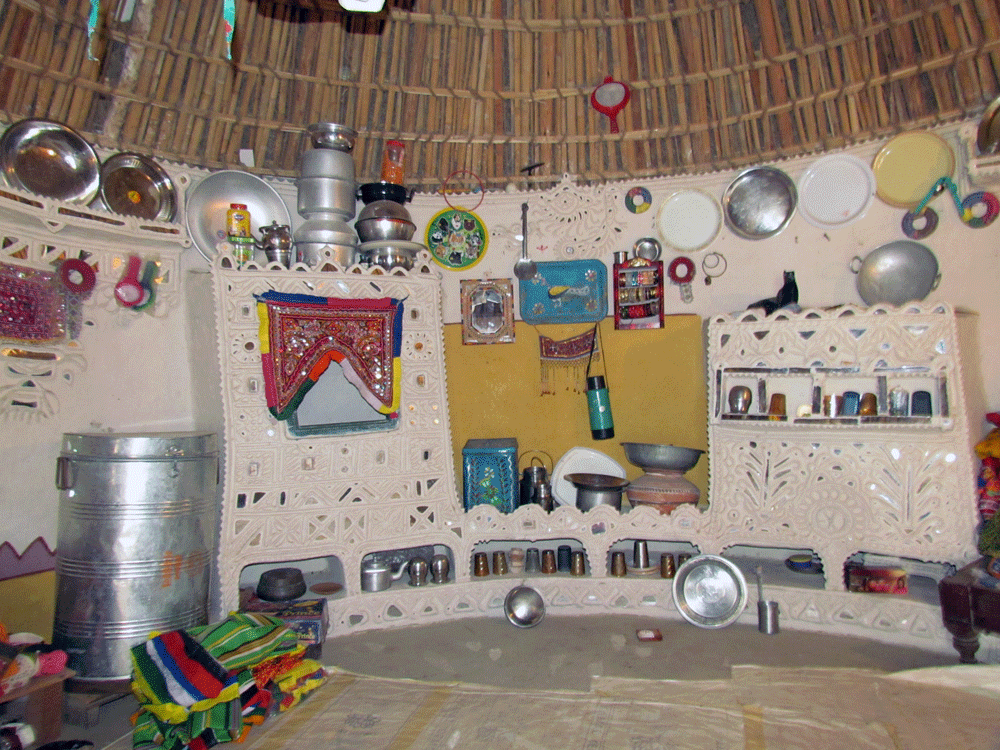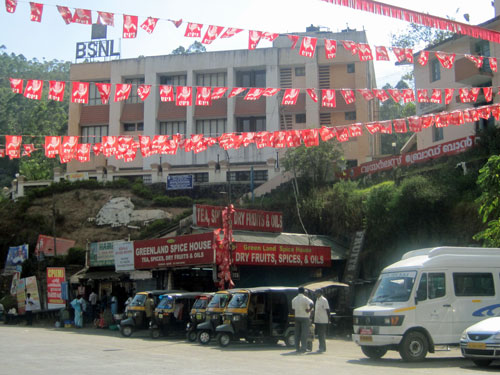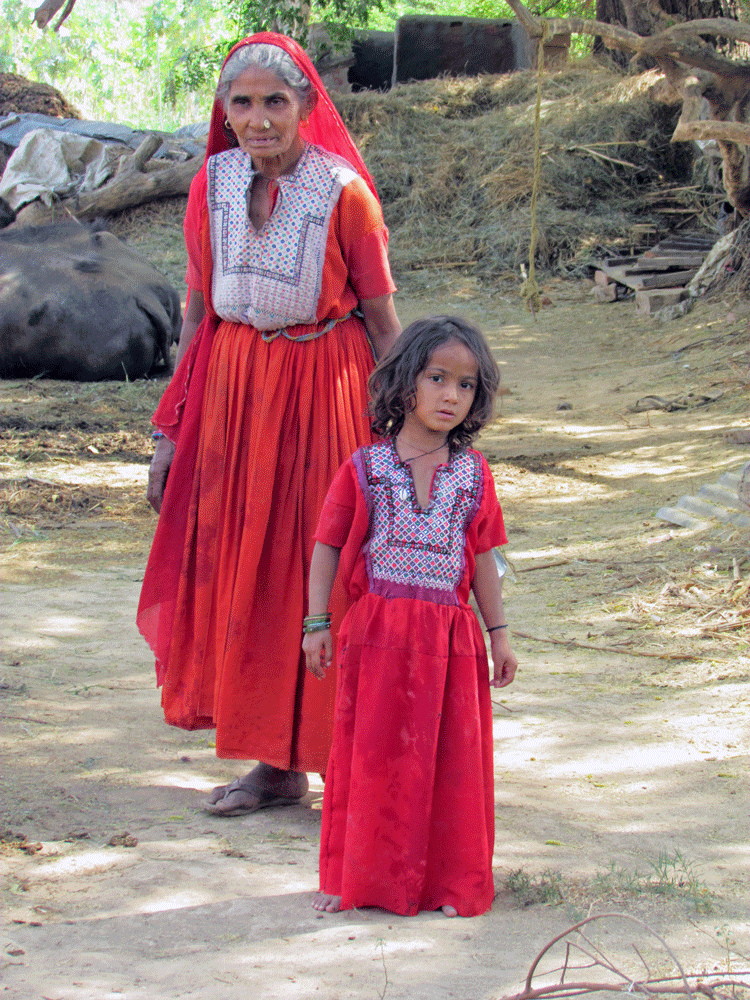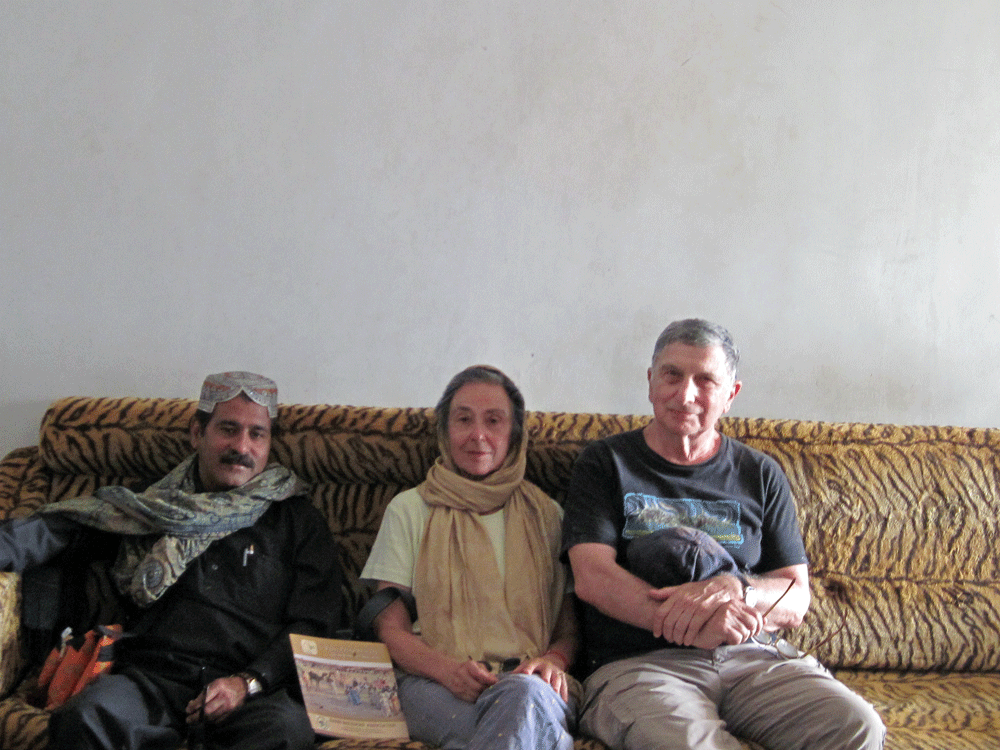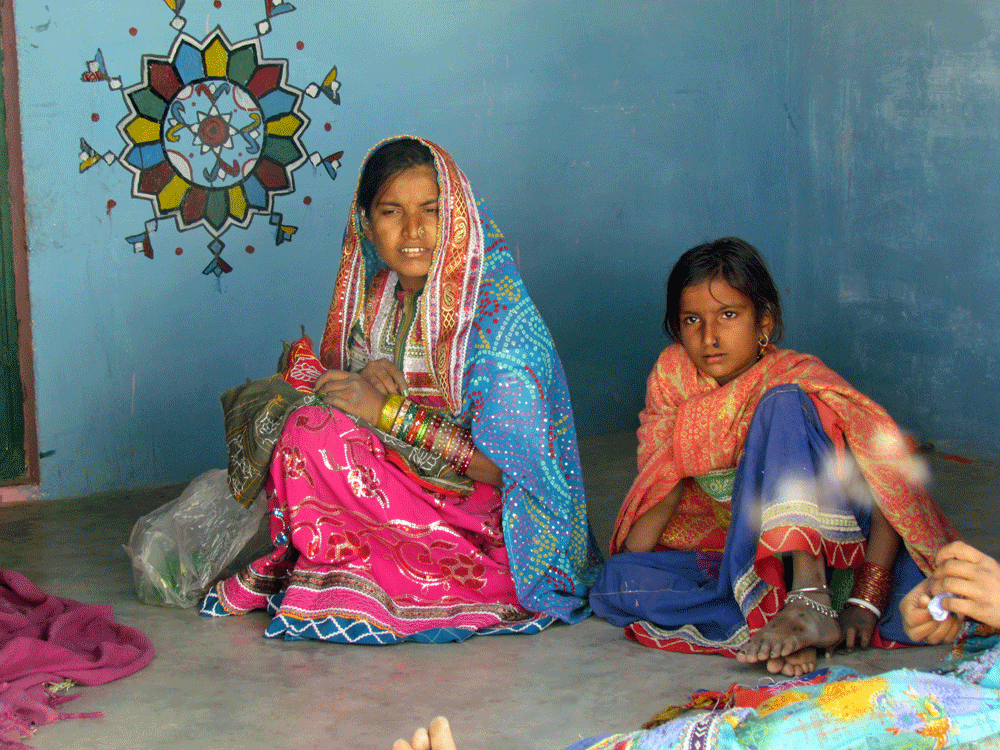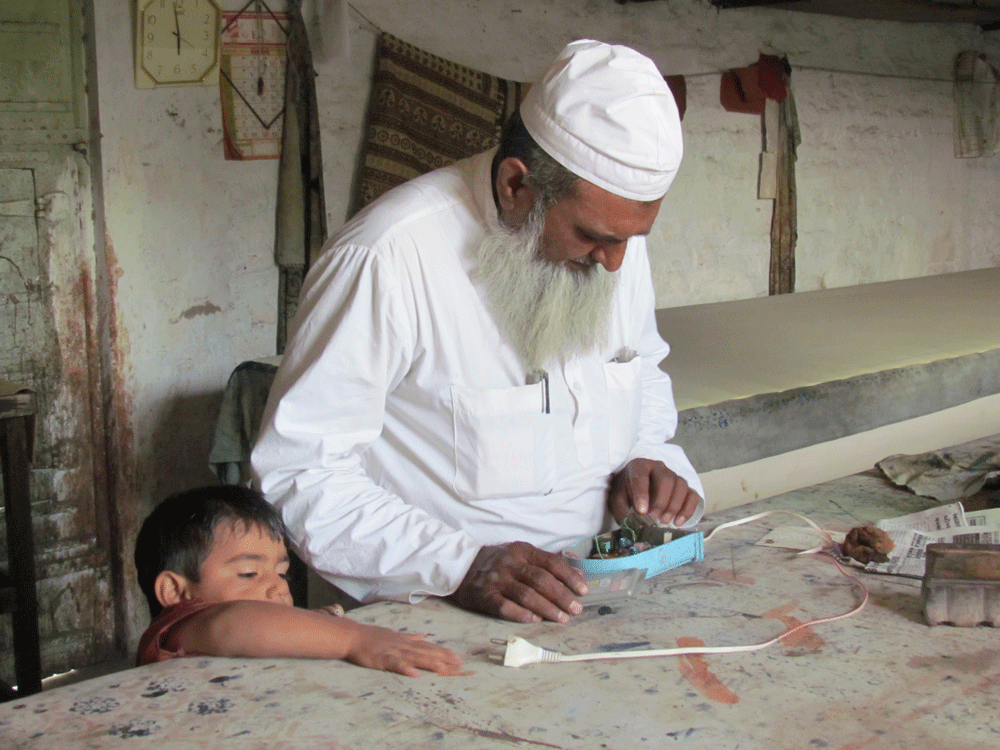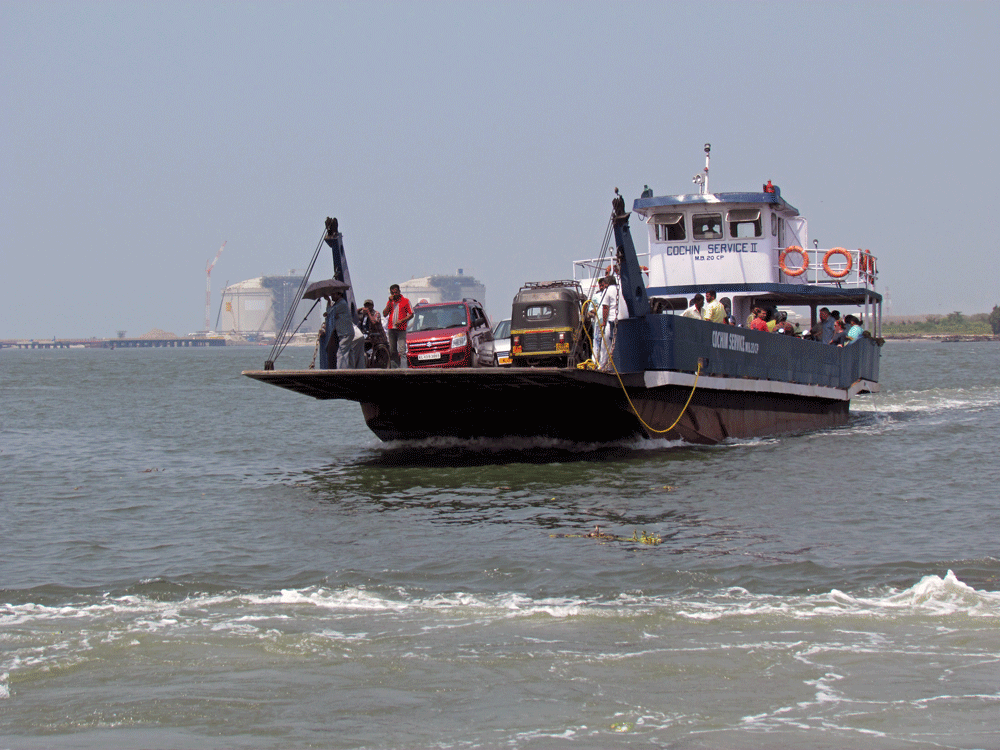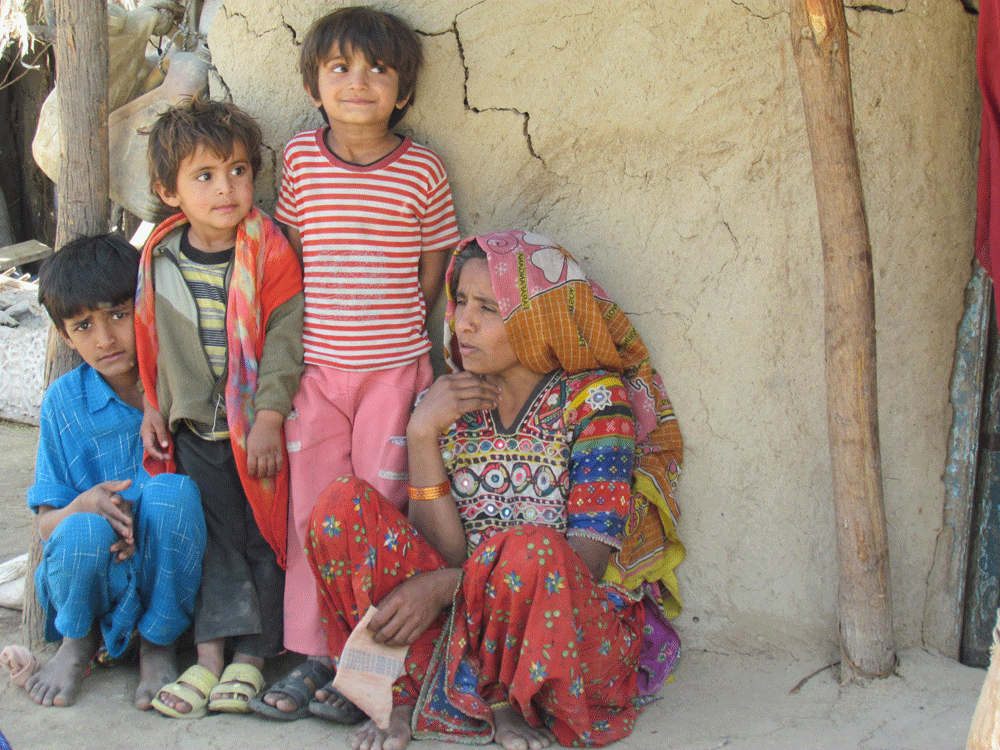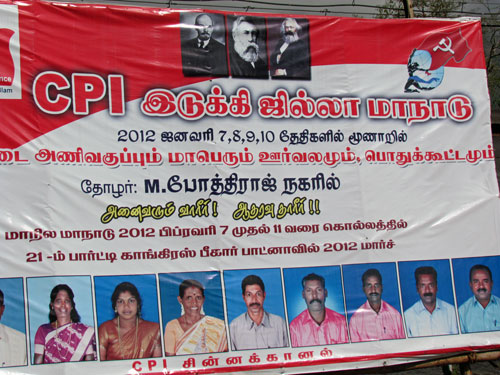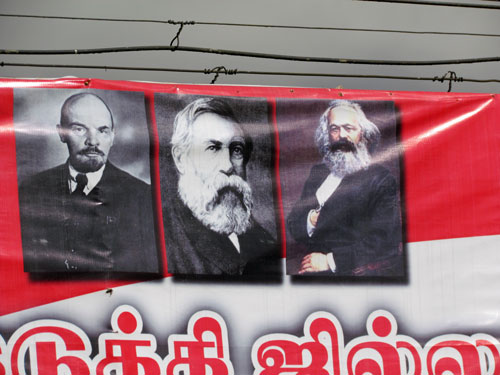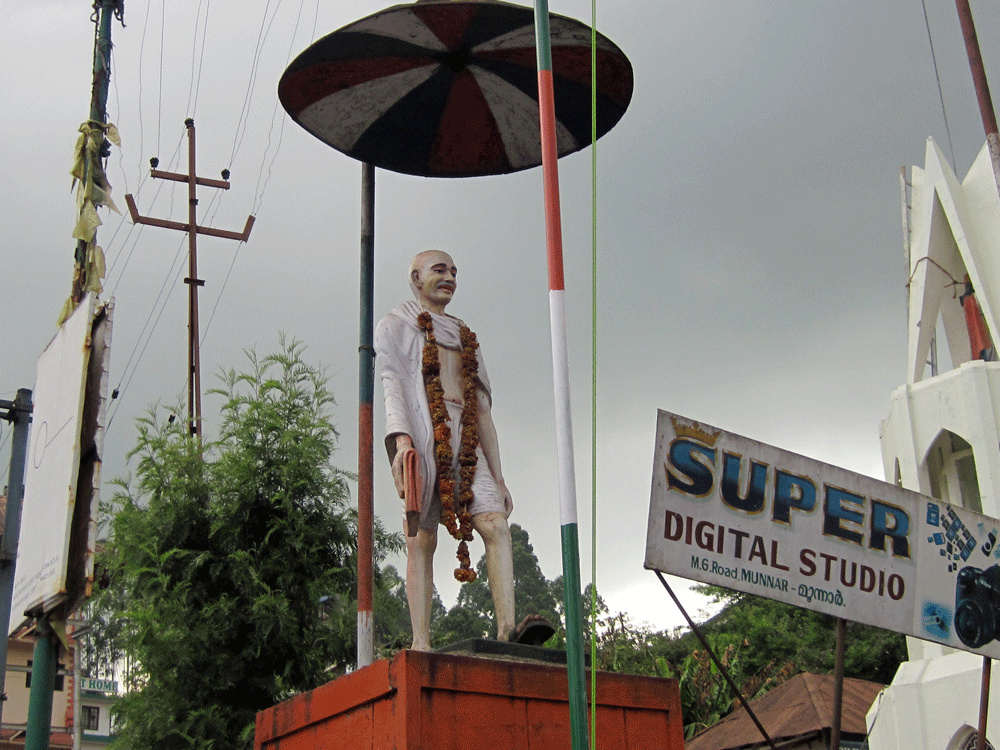
India is said to be many countries. We had never visited the southern ones.
So we flew via Frankfurt to Chennai, capital of the state of Tamil Nadu. If “Chennai”sounds unfamiliar, just think “Madras,” the city’s name until recently. It is the 4th-largest city in India, with a population of 5 or 6 million. Or maybe 8 million. However many, they live mainly in a great sprawl along the Bay of Bengal. It is one of the country’s IT centers. The next time you have a computer problem, you may be talking to someone in Chennai (in the middle of the night).
We arrived at midnight to be greeted by our driver, Jithin, and a big white Toyota Innova. They were our invaluable companions for the next three weeks.
Don’t even think about doing your own driving in India.
They drive on the left (mostly), but that’s the least of it. City streets are crowded (though not always unbearably so, yet), and cars compete with trucks, tuk-tuks(three-wheelers), camels, motorcycles, goats, bikes, bullock carts, rickshaws, cows, and people. Many vehicles urge you to “sound horn,” which adds to the general cacophony. As one of our guides said, traffic lights serve only an advisory function. In the country, vehicles overtake each other with scant regard for solid lines and often with inches to spare. Thanks to Jithin we avoided accidents. But we learned of one nearby that had closed the road for half an hour. The delay was due to the importuning of bystanders offering, for sale to the highest bidder, their services as eye witnesses.
Our trajectory from Chennai was south along the coast of the Bay of Bengal, then inland. The largest Tamil Nadu attractions for most visitors are the Hindu temples. There are many hundreds of these, often of great antiquity. They are typically very high, 200 feet and more in some cases, and covered with ornamental figures. Sometimes they are painted in bright pastels, blue and pink especially. The figures represent manifestations of the numerous Hindu deities, presided over by Brahma, Krishna and Shiva. In the innermost recesses you will often find a Shiva lingam. You know what that is.
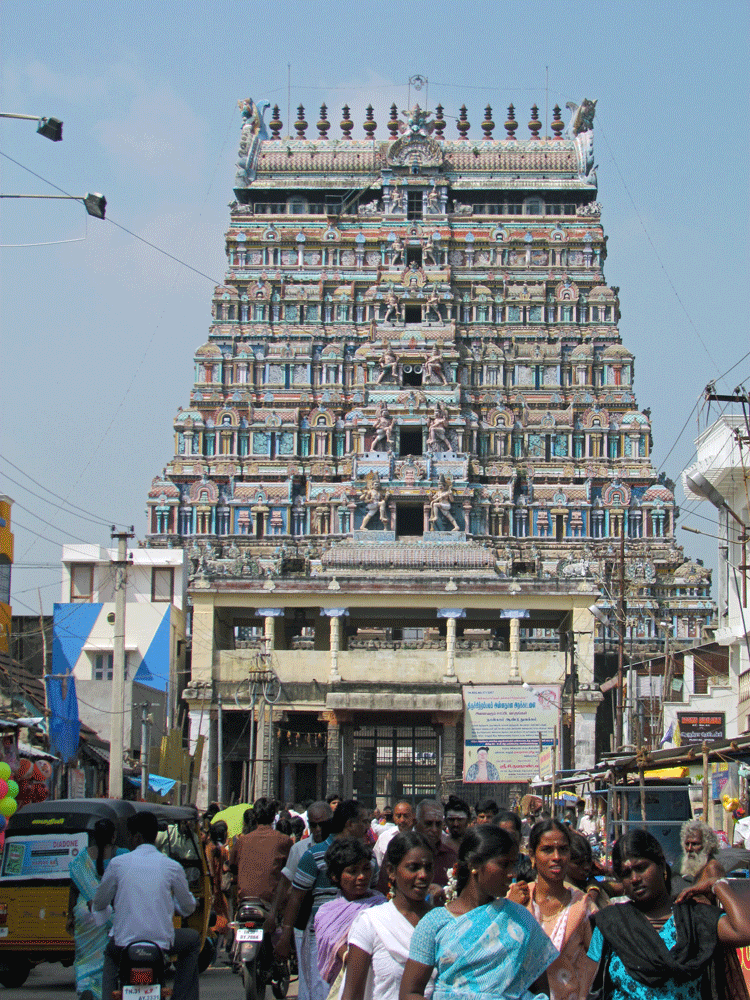
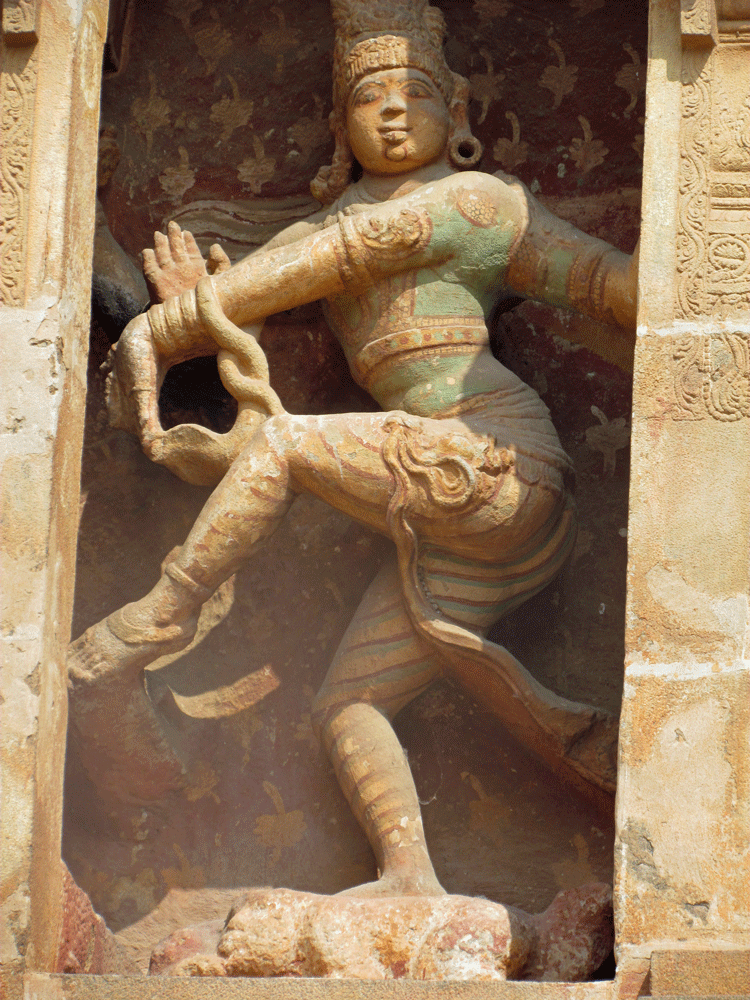
One of our early stays was at Pondicherry, also know as Puducherry or simply Pondy. The town was controlled by the French until 1954, and French is still spoken. We quickly learned that Pondy is not part of Tamil Nadu, but is a Union Territory. Thus, unbeknownst to Jithin, a separate permit was required for the car. Getting it, and finding the hotel, required an hour of direction-seeking, reminiscent of Ghana.
Pondy has an ocean front and lovely French section, as well as the usual chaotic Indian part. Just north of town is Auroville, established in 1968 in tribute to Sri Aurobindo, whose philosophy it is meant to represent. Its main building is a startling sight: globe-like, 100 feet high, it resembles a giant gold-plated puff fish:
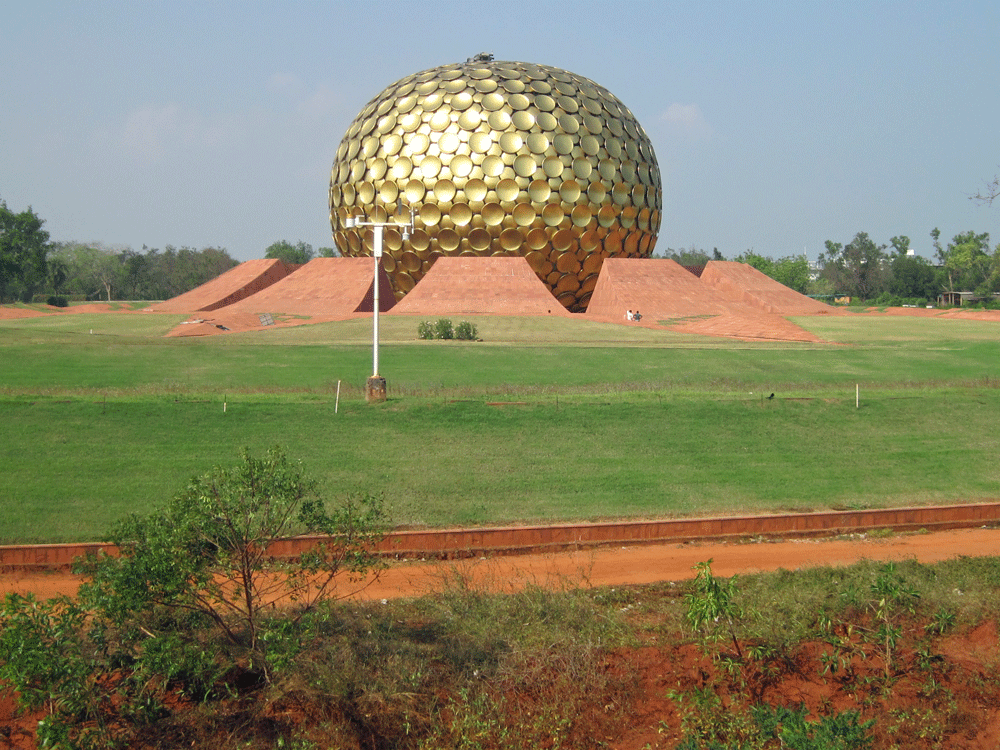
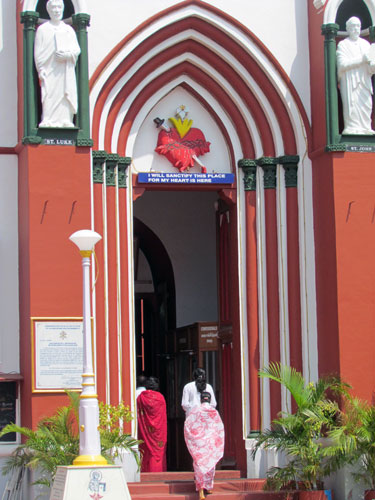
After more than a week of temples, we left the flat surroundings for the mountainous terrain of the Western Ghats. The road was twisty and precipitous; we were again happy not to be doing our own driving. After many vertiginous hours we arrived at a tea plantation in Munnar. It had a very colonial feel. The rooms were large and rather sparsely furnished, with bay windows and fireplaces. There were copies of The Economist and Femina, most over 10 years old. The bill for four dinners and breakfast (for two) was a little over $50. There was a dining room for the guests, never more than 10 or 12. Indeed, for two of our four nights, there were no others. For two nights we had the company of two Parisian couples. They all lived in Paris, that is, but one of the husbands had been born in Brooklyn. His Jewish wife had grown up in Bombay, after her family left Burma, where they had lived for generations. We elicited her admission that her profession was tap dancing. Susan was doubtful, but a Google search revealed that she was famous for this skill.
It was here that we had did our only (very modest) hiking. We strolled among the unreal green leaves of the tea plantation. We saw a number of leaf-pickers, exclusively women. Tea cultivation requires just the right elevation (about 5000 feet), temperature and slope, conditions abundant in these parts. Next day, with a guide, we hiked four or five hours along a beautiful ridge. On the return we plunged into deep forest. We came upon a beautiful cottage perched 15 feet up a stand of trees. It is for honeymoon couples only.
On a subsequent visit we saw a tiger paw print neatly inscribed on some elephant dung. Here and elsewhere we saw many birds and heard the cries of many more. One of these turned out to be a car alarm.
On to Thekkady, where we had a lovely room at a resort with a swimming pool (Spice Village). From here we visited the Periyar National Park, over 200 square miles of lake and forest. The local guides, often recruited from the ranks of reformed poachers, are very helpful.
It was time to move to a new state, Kerala. It has had communist governments, and its literacy rate is the highest in the country. Its population density is also the greatest. 2011 saw 4145 traffic deaths, one-third of them pedestrians. Its many waterways and environs are the setting of Arundhati Roy’s marvelous novel, The God of Small Things. Our first afternoon we were paddled about in a wooden canoe. The following morning we walked along the canal on which our lodging was situated. Folks were doing their laundry in the water that many of them probably drank. Though there are motor boats on the canals (which are greatly endangering the health of the waterways) it is extremely quiet along the waterways. One of the great pleasures of being there was to take an early morning walk among people washing their clothes, their children, fishing, walking to work or school. People were universally friendly. At 11 we embarked on the area’s most popular activity, cruising on a houseboat. It was a sizable affair, with bedroom, dining room, A/C and a large upper deck. Lunch was included. Hundreds of such craft ply, and pollute, these waters. We returned at 5:30. Susan but not I immediately embarked on a sunset cruise.
We were now on the western edge of the country, with the Arabian Sea to our left. We had one night at a true resort, Marari Beach. A lovely beach, but we ventured only a little way into the sea. It is very rough here. In the early morning Susan took a walk on the beach and saw many one-man boats out fishing. It was also her only yoga opportunity on the trip. We did try ayurvedic massage (Susan four times, Steve once). This was quite unusual as we were both introduced to our masseuse or masseur, of the same sex. And, after lying down with eyes closed and having lovely warm oil drizzled on the body--somehow there was an unusual feel to this massage--until we each realized we were being massaged by two people, and therefore four hands. After the initial surprised, it proved to be quite pleasant. For Susan the ultimate experience was being washed in a warm shower by her masseuse afterwards.
Our next major stop was Cochin, now known as Fort Kochi. Guidebook says: “Kochi has acted as a trading port since at least Roman times, and was a link in the main trade route between Europe and China.” It is still a busy place, although most of the commercial action is in its twin city, Ernakulam. There is a picturesque and active water front, with the view scarred by big oil rigs. Fisher folk spread their expansive Chinese fishing nets. The brown water did not look very good for fish or for people. For about five cents each, we took a short ferry to the agreeably rural Vypeam Island. One lunch was at the outdoor Bob Marley café. We inquired about weed. Just curious. Could be got, we were told. But the owner hadn’t offered out of respect for our age.
We made sure to get to Jew Town: that’s what it’s called--see photo. Most of the Jewish community has left for Israel, but a synagogue serves the few who remain. We also had a (non-kosher) meal in the area and visited the Chabad House with its young rabbi and his wife. Other stops were the Mattacherry Palace and Parikshith Museum. Wall-to-wall gaudy murals in the palace. The guidebook describes a couple of them as “triple x-rated.” In one of them, “deer, birds, and other animals are captioned as giving themselves up to ‘merry enjoyment’”; in another, Krishna “finally works out why he was given so many limbs.” Neither of these was on view when were there, alas.
After three weeks, it was time to abandon the security of Jithin and the car. We flew 900 miles north, via Mumbai, to Ahmedabad, former capital of the state of Gujarat. At the airport we were met by another driver and another white Toyota Innova. We stayed at the city’s premier hotel, the House of MG. Only 12 rooms, all enormous, and two fine restaurants. Susan was a delighted that there was a swimming pool, as there was at our next destination. Unhappily, neither pool had any water.
Gujarat is now peaceful, after a terrible start to the century. In 2001 a major earthquake killed 20,000. We met many people who had lost a family member. Little more than a year later, 58 Hindus aboard a train were killed by Muslims. Reprisals were horrifying. We were a long way from the lush, watery south. Gujarat is substantially desert. It is also dry in the other sense, thanks to Gandhi.
Ahmedabad has many attractions. The Calico Museum, was an experience. One must reserve in advance and come prepared with copies of passports and visa, and wait at least a half hour. There is a tour, with questions very much discouraged. Altogether a fascinating glimpse of an enormous collection but very frustrating. Our guide was able to entertain us with gossip about the owners of this collection; this helped explain the odd viewing experience. Many mosques and temples. Le Corbusier designed the Institute for Design. The huge brick Institute of Management, designed by Louis Kahn. And of course a great amount about Gandhi: An excellent museum and the famous ashram, from which he undertook his salt march to the sea in 1930. This was a milestone in his campaign for Indian independence.
Our Gujarat guide was Sam Neill. That was one of his names, ascribed to an Irish great-grandfather. Sam spoke many languages: French and German, as well as several local ones, and English. He was endearingly opinionated, at least if you agreed with him. His view of colleagues could be caustic. “That driver is so stupid. When I say go here, he goes there. When I say good morning, he says good night.”
He had a bottle of whiskey, because sipping it made him feel “dynamic” the next day.
Our first stop outside Ahmedabad was Patan. Don’t miss the 11th-century Jain temple, Rani ki Vav. It is built seven stories into (not above) the ground. The myriad sculptures are well preserved and meticulously detailed. We spotted some pubic hair in one of them. Eroticism is one of the attractions of many Hindu sites.
A long drive took as west to the area of Bhuj, which was still shows plenty of earthquake damage. Our principal stay in the region was at the Shaam e Sarhad Village Resort. The name means “sunset at the border.” The border is with Pakistan, and one needs a permit (easily obtained) to go anywhere near it. We drove near the border one evening to find a desolate endless plain covered with salt deposits. This is the southern side of the Great Rann of Kutch. The sun hung hazily in the sky for some time, but did eventually set beautifully, as promised.
The Resort was more basic than our previous stops. No swimming pool, with water or without. What water there was arrived in the morning in two big buckets, one of hot water, one of cold. We stayed in a tent. Not what you may imagine. It was about 20 feet by 15, with vertical walls and two comfortable beds. Like many other desert spots, it was warm in the day but cool at night. The beds had heavy comforters. The strictly vegetarian food was excellent, though there was no real coffee for the first time--just Nescafé.
On our last desert night we attended (part of) a Hindu wedding. It was relatively small, perhaps fewer than 1000 guests. Later Sam shared a little of his whiskey with us. Susan was very warmly welcomed by the bride and her girlfriends. They probably thought she was one of the odder women they’d ever seen - no glittery clothes, short hair, no gold chains. 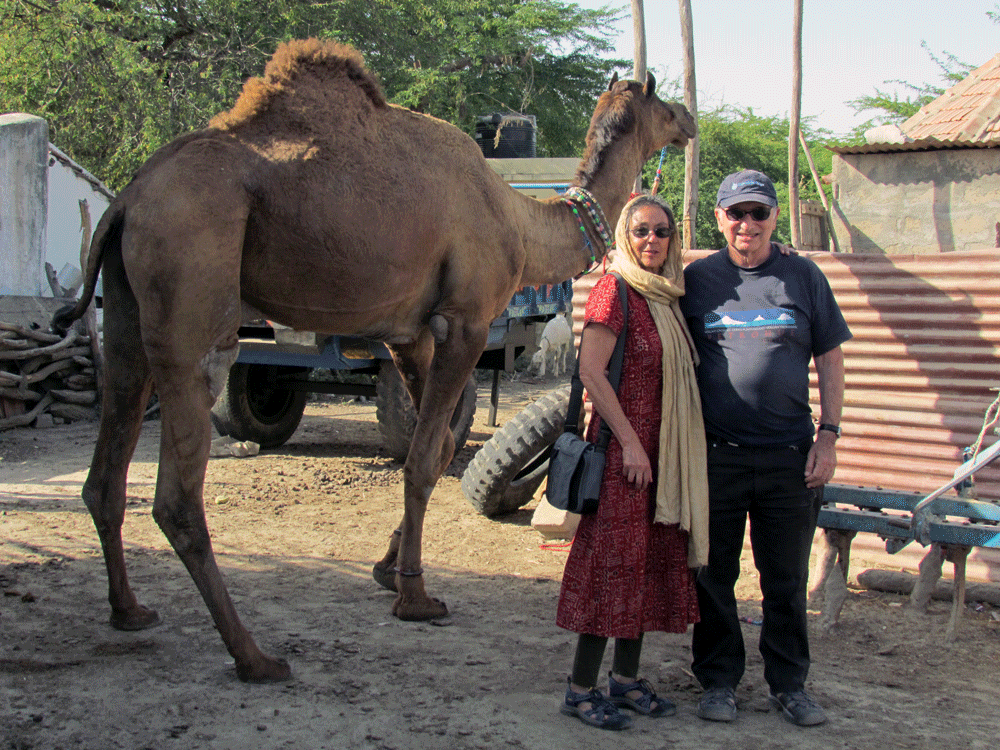
We flew to our final destination, Mumbai (Bombay). It’s an enormous place, the “maximum city” of dreams an nightmares. By mid-century its population may reach 20 million, nearly equalling that of all Australia. We stayed in the southern, most historical section. Our best view of the famed Mumbai squalor was from the air: huge expanses of tightly-packed tin-roofed shacks, right next to big white high rises.
We stayed at the Taj President Hotel--pretty luxurious, but inexpensive by U.S. standards. It is right by the beach where Pakistani terrorists initiated their 2008 attack on the Taj Mahal, the city’s grandest hotel. We visited its gorgeous lobby, which has a waterfall next to a tasteful plaque memorializing the victims of the attack. Security can be pretty tight: many hotels x-ray bags before admitting them; our bags were x-rayed every time we entered the hotel.
Even the comparatively small section of the city where we stayed has a great deal to see. Museums, palaces, etc. Excellent restaurants. We recommend Trishna and Khyber. A truly obligatory destination is Elefanta Island, six miles (an hour by ferry) away. There you can see Jain, Buddhist and Hindu carvings in huge excavated caves. In the 16th century Portuguese occupiers contributed to cultural history by using many of the statues for target practice. But a great deal remains.
We were wondering about the fabled city traffic. The long ride from the airport had been easy, and our hotel area was fairly quiet. But then one afternoon we took a taxi to a market area. We encountered a many-streeted intersection. The traffic light would be red for two minutes, then green for ten seconds. Everyone ignored it anyway. You haven’t seen true gridlock unless you have been in Mumbai (or Bangkok, Jarkata et. al.). We somehow got through in less than eight or ten minutes. Incidentally tuk-tuks are banned from the southern part of the city, with limited benefit.
International flights typically leave India at midnight or after. Good to leave plenty of time. We got through immigration and security with surprising ease. But we weren’t done. There was another, stricter security barrier, after which we were stationed for some time in a departure lounge with too few seats. but the flight itself--8000 miles, nearly 16 hours--was smooth and even enjoyable, if you like that sort of thing.
Food: There’s a vegetarian emphasis, but with options. Many small restaurants advertise as “veg or non-veg.” Beef is of course unavailable, and red meat is relatively rare. But fish and especially chicken are easily found. The most common meal is a Thali: rice and bread atop a metal plate or banana leaf. Accompaniments in small metal bowls are lentil, pickle and such. Some places serve the whole meal for about $1.00. The food was fabulous. Steve even said that, if he could eat that way every day, he could be a vegetarian. We were not very successful at eating with our right hand only, and often resorted to a spoon.
People: The Indians were very welcoming. We met the usual assortment of visitors, many of whom were widely traveled. One was a young Hindu woman who had been adopted at six weeks by a French couple, who were with her. She spoke French, English, and some Hindi. She had been studying Sanskrit, which she said was really hard. Other young women were two medical students from Columbia University, one whose family was from the Dominican Republic, the other African American. She had graduated from Harvard, where she lived in Eliot House. In my day, this was the abode of white preppies.
Literature: The cities have excellent bookstores, though some of them devote a lot of their space to DVDs of foreign and, naturally, Indian movies. Indian fiction in English is a growth industry. In Chennai I invested in volume 2 of The Blaft Anthology of Tamil Pulp Fiction. Fort Kochi had a Penguin India copy of Arundhati Roy’s early screenplay, In Which Annie Gives it Those Ones [sic.]. Some of it is in Hindi. It’s very funny.
Languages: hundreds, usually completely different. Some very difficult. English and Hindi are national languages, but many people can’t speak English and many don’t want to speak Hindi. We were told that, in part because of language, people generally feel more identified with their state than the country of India, which can certainly add to political problems.
Newspapers: They are abundant, in many languages. They feature pictures of film stars, and stories about them. The actresses are invariably light-skinned, with long dark hair. They are all beautiful. Matrimonial ads also abound, e.g., “Doctor, 4,00,000 [about $2000]/-PA, wants doctor groom, Golden Hands, Matrimony”; “working spinster seeks teetotaler groom in and around Chennai only”; "Devar, 34, B. Tech., Chennai, Aswini prefers Mukkulalthore employed girl. Caste no bar.”
Textiles: (by Susan):
Having just arrived in Chennai, I was still jet lagged and overwhelmed--and therefore not really ready for serious shopping. And what a shame that was because I was not prepared for Kanchipuram, home of the Kanchipuram sari! Every area of India has a rather distinct sari and I learned, for example, that the quintessential Kerala sari is white with gold borders. The Kanchipuram silk sari is very colorful, known for being woven with three single silk threads (though some articles say it’s as many as four or five) held together, with gold and silver borders. I was too overwhelmed to make any intelligent purchases; I also realized later that they were much too bright and lustrous for my taste. (My taste does run to buying saris--all that wonderful cloth--and getting home and not knowing what to do with them, other than look.)
Our next--and more satisfying--textile adventure was in Munnar, among the Tamil Nadu tea plantations. Tata, the manufacturer of cars and owner of tea plantations (until they were recently sold to their workers!), has developed a natural dye studio and workshop for disabled adults. They are doing beautiful work. They have very nice facilities and have a lovely young woman from the National Design Institute in Gujarat working with them. I did buy a sari there and also some hand-dyed and printed cloth that I had made into a salwar kamiz.
Our major textile/craft destination was Bhuj in Gujarat. I thought I was prepared for what I would see and experience, having read several books about Gujarati textiles – but it was impossible to not be visually overwhelmed by the work being done there by both men and women. And of course, I returned with major textile regrets (the things not purchased!) Bhuj is an eight hour drive from Ahmedabad. We had to make a detour to stop in Patan, one of the three locations in the world that make cloth with both weft and warp ikat (a resist technique, wrapping threads to keep dye off the cloth). I have visited the town in Bali that dyes and weaves double ikat; still have to get to Japan! There is only one family doing this work, and only the men do the weaving and dyeing. We were told that there is a six year wait for a double ikat sari! And, of course, they are very expensive. I was hoping – really, really hoping – to get a sample of the work but a previous visitor had bought up all their samples. Mr Salvi made a phone call to try to find me a piece to buy but was unsuccessful Like many of the artisans we met in Bhuj, the family sells only from their home and has no outlet in a town or larger city. They don’t need one!
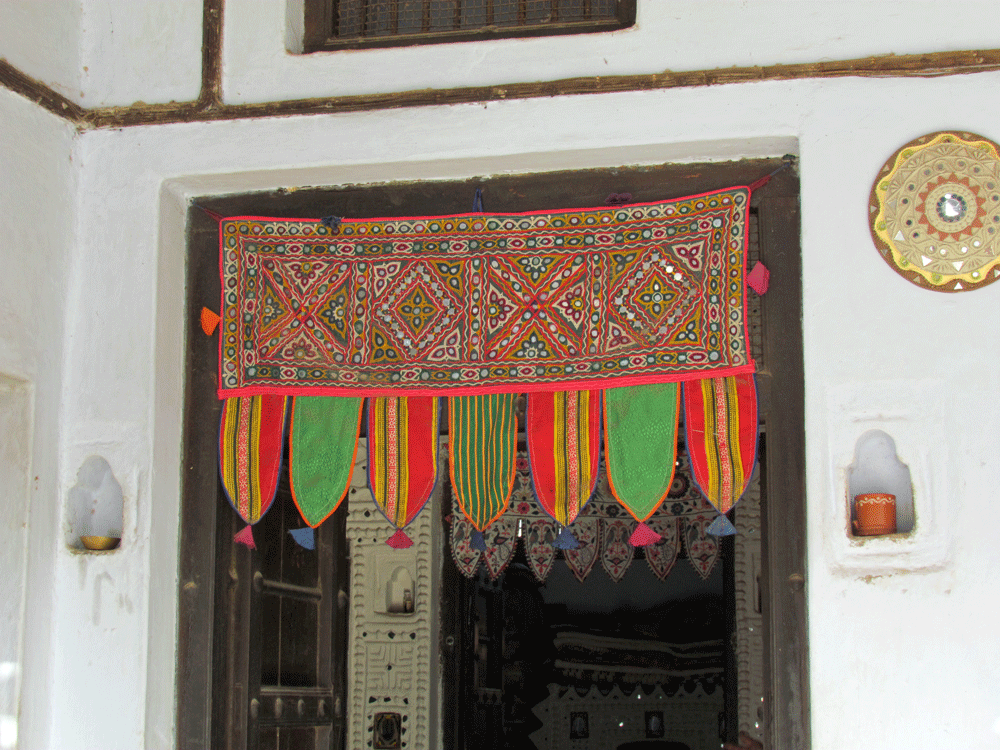
We made two more stops before reaching our “home” for the next two nights. The first was in a Moslem village where Mashru weaving is done. Women are the weavers here, using a pit loom (sitting on the floor of their home, with a pit dug into the clay floor and the pedals down below); they weave a warp faced length with a silk warp and cotton weft, with very fine threads! This cloth is woven for Moslem men who are forbidden to wear silk next to their bodies. The cloth is then dyed (by men) and often printed or embroidered. And it is beautiful! You can admire my jacket made in Mumbai from a piece of this cloth, and my embroidered shawl. Again, this family has no outlet other than in the village, and there was almost no bargaining expected or accepted.
The last stop of the day (poor Steve!) was at D. Ismail Mohammed Katri’s block printing establishment. Many – or most – of the artisans we visited had a proudly displayed prize from the State displayed and they all seemed well deserved. I’ll show you my salwar kamez made from a piece of his double-printed cloth. He uses chemical dyes, indigo and also, increasingly, natural dyes. After the earthquake ten years ago he was forced to move, as access to the local river was destroyed. He is quite sophisticated and also seems increasingly aware of environmental issues, such as discharge of dyes into the water system.
The next morning we began our textile and artisan tour with a visit to a village that specializes in making wooden kitchen spoons and tools that have lacquer covered handles. These are quite colorful; visitors to our home will see how unusual they are. This is a craft practiced only by men, and only in this village. All the work is, of course, done by hand but one wealthier family we visited had an electric sander, quite a step up from hand sanding. Their children were dressed in school uniform while, we were told the children right next door, in another family compound, did not go to school. This was in sharp contrast to almost every village we visited.
Our next visit was to a family of Rogan painters; their car has a license plate that declares their profession! The uncle, his nephew and their families (these means the men) are the only people anywhere still practicing this art. A book on Gujarati textiles defines Rogan art as “textiles decorated with a design drawn by hand in a paste made from boiled castor oil and pigments.” It is amazing to see these intricate designs painted with a metal stick, using pigment spread on the hand, and with no drawing of the picture to be painted. The most often seen design is of the tree of life, a Moslem symbol. The boys in the family begin this work when they are about fourteen.
In Bhuj, we traveled among both Hindu and Moslem communities; we were welcomed and offered tea (many, many cups) everywhere! As all women cover their hair (as I did when visiting the villages) and very few men wear turbans or hair covering, we often knew the religious affiliation of a family only when told by our guide. Some Moslem villages do not have mosques (rare but so) while all Hindu villages have temples. Very few of the villages have madrassas. The women do not wear saris; they wear skirts, hair-covering shawls that can be moved to cover the face, and blouses. In some areas the blouses are backless (cooler in the heat?) but covered with a shawl. All very, very colorful, with red the favorite color. And all elaborately embroidered! Although women were almost always eager to sell some of their work, they were not selling their priceless family heritage as they were continuing to work and produce more embroideries. Many people wanted photos taken, especially of their children. And everyone wanted their one room home entered and admired.
We next visited a bell maker, in a nearby village. The bells we saw being made were traditionally worn by cattle and buffalo but, more recently, their use has been abandoned (not sure why) so the family is happily selling to tourists. This was one of the few places where we saw husband and wife working together. The sounds are incredibly clear and lovely; Steve had to pry me away from the larger samples but, of course, we did come home with a small one.
Our last visit for the day was to a weaver who has a rather large workshop. The men weave in wool with pit looms. The traditional shawls they make are very colorful and worn by men and women. They are now also weaving beautiful indigo shawls (why didn’t I buy more?). The men were very interested in the photos I showed of my loom and my work.
The next day we visited a pottery maker. (Again, look for the sample in our home.) Although traditionally the husband makes the bowls and his wife paints them, the husband was away for the day and his wife was very comfortable using the wheel while other women were painting the intricate design. Steve was interested to see the ways in which the wheel was similar to his mother’s and how it was different.
Everywhere we visited we saw women embroidering. I am not sophisticated enough to describe the different styles of embroidery; I can mainly differentiate--with small mirrors or without! It seems there is not an extra moment that is not spent in embroidery--which also generally means sitting with a group of women including your daughters, talking, laughing, enjoying the company. This is not a solitary endeavor. I bought very little as I was too overwhelmed. I did buy one bag on our first afternoon in Bhuj; I knew I didn’t love it--and promptly cut off the little plastic pieces sewn along the edge. But the seller was one of the more insistent women we met and I was too tired to say “no.” So I got confused, thought I had bargained successfully (one of the few bargaining opportunities)--and brought the price down from $52.00 to $50.00! I do have trouble with those rupees. This bag, which is not one of the older ones, reflects the current trend of using a lot of glittery tape on clothing and bags. Which I don’t like but is very popular. So at least I can say it is a good example of the latest trend!
The most beautiful embroidery we saw, because it was distinctive, was being done by a young woman who was working by herself. Her English, self-taught, was quite good. She has been visited by women from Canada and the US who are studying embroidery (and has been written up in Travel and Leisure Magazine!) She embroiders quilts (too big to bring home for me, sadly) and cloth (of course, I do have a smaller example). She is using a style and technique that she learned from an aunt and is the only woman still doing this style of embroidery. She is quite aware of her “responsibility” to keep this tradition alive but says she is determined to have a better education for her daughters. As I had become aware that several of the men we met had traveled to cities of India or to the US to show and sell their wives’ work, I asked if she had ever been to the US or abroad to show or teach her technique. She said, “This compound is my Europe”; it seemed clear that this was okay for her, as she was working towards goals for her daughters. Her husband has a good job, so her income is not needed to keep the family going (and this was true of many of the women we met as the husbands are fully employed making charcoal --called the “black gold” of Gujarat as it is shipped throughout India or are herders who sell the milk from the cows and buffaloes). She proudly told me that the money she earns does not go into bangles, or even into a box on her shelves; it goes to the bank for her daughters’ education.
Oh yes, and there were the quilt makers! Gujarat and Bhuj are well-known for their appliquéd quilts (and again, we can show you an example.) Luckily, I don’t know much about quilting so I can’t say much except I really like the one we bought.
One of the last visits we made was to a craft school, Kala Rasksha which was developed by an American woman who has lived in Bhuj for many years. Women work from their home and her organization sells the products. Our last visit, the day of our departure on our way to Bombay/Mumbai was to see some tie-dyeing. The man we visited works with his father (whose work has been in Yoshiko Wada’s book on shibori. In tie-dyeing the woman ties the fabric --and we are talking about the tiniest resist areas imaginable--and the man does the dyeing. This workshop is shifting to natural dyes though they still use some chemical dyes. They are very aware of what is being done internationally in textile design but, again, sell only from home as they have a small staff and don’t need to expand! (How lovely.) Of course, we have a beautiful example of this too.
